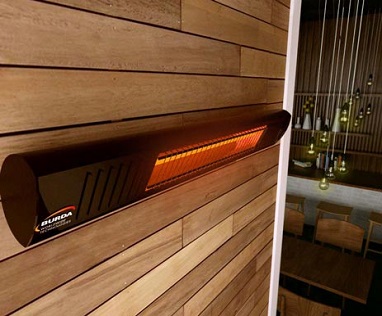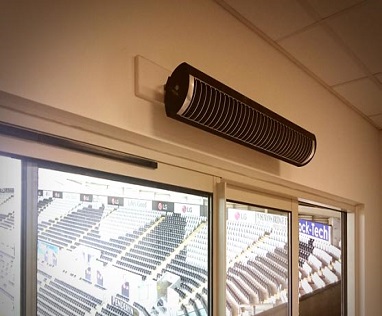How Does Infrared Heating Work?





WHAT IS INFRARED HEAT?
Infrared is part of the electromagnetic spectrum and is a form of radiated heat – the most basic form of heat we know. It's 100% natural and the same type of heat we ourselves emit and absorb on a daily basis. The warmth of the sun on our skin, the soothing glow of an open fire, and the warm feeling when we sit close to other people are all examples of infrared heat at work.
A basic principle of heat transfer is that heat moves from hot to cold spaces. We absorb infrared heat when we are colder than our surroundings and emit infrared heat when we're warmer than our surroundings. That's why infrared is used in incubation units for babies, to deliver that same level of comforting and natural heat. It’s also the reason why infrared thermal imaging is used by the police to find criminals on the run as their bodies give off infrared heat which makes them easy to find. Infrared radiation warms the objects and people in its path, rather than just heating the air. This makes infrared heating much more efficient than convection heating, which is the form of heating used by conventional radiators and oil or gas central heating systems. Convected heat warms the air only, which circulates uncontrollably and leaves the surrounding fabric of the room cool. Direct radiated heat warms everything it touches, bringing a lasting, comfortable heat to your home whilst consuming less energy.
WHY HAVEN'T WE ALWAYS USED RADIATED HEAT?



Well, in a way, we always have. Many of the earliest forms of heating used radiated heat, just think about the way wood fires warmed our ancestors. The same form of heat was used in Roman hypocausts, warming luxurious bath houses through a system of furnace-heated tiles. However, the discovery of plentiful supplies of fossil fuels such as gas and oil, and the invention of central heating systems provided an alternative heating solution in the form of radiators. This quickly becmae the most popular method of domestic heating.The name “radiator” is a bit of a misnomer as radiation only makes up a third to a quarter of the heat emitted by these ubiquitous household heaters – the rest is inefficient convected heat. However, with gas and oil readily available at much cheaper prices than the cost of electricity tariffs, fossil fuel central heating became the standard fare for most British households. Despite being cheaper, fossil fuels are notoriously less efficient.
Today we realise that these fossil fuels will not last forever, prompting scientists and engineers to search for more efficient, sustainable heating solutions. Infrared heating is that solution. Our top-of-the-range infrared panels and heaters produce comfortable radiant heat so efficiently that they're cheaper to run than conventional central heating. When used with electricity generated from a sustainable source they're one of the few entirely green heating solutions available. Efficient, affordable and eco-friendly, we firmly believe that infrared heating is the heating of the future, overcoming all of the disadvantages of central heating without an increase in running costs.
WHAT IS FAR INFRARED?

Infrared: Optimum Comfort Heating
Far infrared is the form of infrared best adapted to provide comfort heating. Infrared forms part of the electromagnetic spectrum, encompassing a range of radiation waves with different wavelengths and frequency levels. At the near or shortwave end of the infrared spectrum you'll find higher frequency waves with short wavelengths. These waves have high transmission which means they penetrate further into an object's surface. However, they also have low absorption, so the heat is less easily absorbed into the core of the object. In practice, this means that near infrared heaters provide a strong level of heat at surface level but struggle to warm people at a deep level. Quartz heaters and tungsten lamps are examples of products that use near infrared and give off a bright light when in operation. Near infrared provides a useful source of on-demand heat in outdoor locations, but is not a suitable long term permanent heating strategy.
The further you move along the infrared spectrum, you'll find lower frequency waves with longer wavelengths, which have lower transmission but are more easily absorbed. Far infrared is the optimal form of infrared for comfort heating as its gentle, low transmission waves are easily absorbed by skin tissue and are quickly transported around the body, providing lasting comfortable warmth. This makes it the most efficient form of infrared because it uses less power to heat more effectively. It's used in incubators for babies because it provides that perfect balance of gentle yet thoroughgoing heat.
Where Can You Use Infrared?
Indoors and outdoors, domestic and commercial – infrared heaters can be used everywhere! Efficient, eco-friendly and more comfortable than conventional central heating systems, infrared heaters are ideal heating solutions for all domestic and commercial spaces. They're especially useful in warehouses and outdoor locations because they overcome the problems of convection heaters that have made these spaces almost impossible to heat in the past. Convection heaters only work when they can heat an entire space – that's a very large space inside a warehouse, or an infinite space in outdoor locations! Infrared heaters, however, can provide directed heat wherever it's needed. This means you don't waste power needlessly heating an entire warehouse and heat isn't lost through the circulation of air. Infrared provides superior energy-efficiency and effective, far-reaching warmth – it's a heating revolution for all large and open plan spaces.
VIEW OUR RANGE NOW
For more information about whether infrared heating would be a good choice for your home, speak to our expert heating advisors on 0330 880 8383










